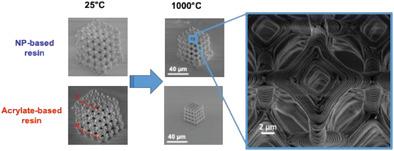Our official English website, www.x-mol.net, welcomes your
feedback! (Note: you will need to create a separate account there.)
3D Printing and Pyrolysis of Optical ZrO2 Nanostructures by Two-Photon Lithography: Reduced Shrinkage and Crystallization Mediated by Nanoparticles Seeds
Small ( IF 13.0 ) Pub Date : 2021-09-14 , DOI: 10.1002/smll.202102486 Anne Desponds 1 , Akos Banyasz 1 , Denis Chateau 1 , Azeddine Tellal 1 , Amandine Venier 2 , Sylvain Meille 3 , Gilles Montagnac 4 , Jérôme Chevalier 3 , Chantal Andraud 1 , Patrice L Baldeck 1 , Stephane Parola 1
Small ( IF 13.0 ) Pub Date : 2021-09-14 , DOI: 10.1002/smll.202102486 Anne Desponds 1 , Akos Banyasz 1 , Denis Chateau 1 , Azeddine Tellal 1 , Amandine Venier 2 , Sylvain Meille 3 , Gilles Montagnac 4 , Jérôme Chevalier 3 , Chantal Andraud 1 , Patrice L Baldeck 1 , Stephane Parola 1
Affiliation

|
Two-photon lithography is a potential route to produce high-resolution 3D ceramics. However, the large shrinkage due to the elimination of an important organic counterpart of the printed material during debinding/sintering remains a lock to further development of this technology. To limit this phenomenon, an original approach based on a composite resin incorporating 45 wt% ultrasmall (5 nm) zirconia stabilized nanoparticles into the zirconium acrylate precursor is proposed to process 3D zirconia microlattices and nanostructured optical surfaces. Interestingly, the nanoparticles are used both as seeds allowing control of the crystallographic phase formed during the calcination process and as structural stabilizing agent preventing important shrinkage of the printed ceramic. After 3D photolithography and pyrolysis, the weight and volume loss of the microstructures are drastically reduced as compared to similar systems processed with the reference resin without nanoparticles, and stable 3D microstructures of cubic zirconia are obtained with high spatial resolution. In the case of a patterned surface, the refractive index of 2.1 leads to a diffraction efficiency large enough to obtain microfocusing with linewidths of 0.1 µm, and the demonstration of a microlens array with a period as small as 0.8 µm.
中文翻译:

通过双光子光刻技术对光学 ZrO2 纳米结构进行 3D 打印和热解:减少纳米粒子种子介导的收缩和结晶
双光子光刻是生产高分辨率 3D 陶瓷的潜在途径。然而,由于在脱脂/烧结过程中消除了印刷材料的重要有机对应物而导致的大收缩仍然是该技术进一步发展的障碍。为了限制这种现象,提出了一种基于复合树脂的原始方法,该方法将 45 wt% 的超小 (5 nm) 氧化锆稳定纳米粒子掺入丙烯酸锆前体中,以处理 3D 氧化锆微晶格和纳米结构光学表面。有趣的是,纳米颗粒既用作种子,允许控制在煅烧过程中形成的结晶相,也用作结构稳定剂,防止印刷陶瓷的重要收缩。经过 3D 光刻和热解,与使用不含纳米颗粒的参考树脂处理的类似系统相比,微结构的重量和体积损失显着减少,并且以高空间分辨率获得稳定的立方氧化锆 3D 微结构。在图案化表面的情况下,2.1 的折射率导致衍射效率足够大,可以获得线宽为 0.1 µm 的微聚焦,以及周期小至 0.8 µm 的微透镜阵列的演示。
更新日期:2021-10-21
中文翻译:

通过双光子光刻技术对光学 ZrO2 纳米结构进行 3D 打印和热解:减少纳米粒子种子介导的收缩和结晶
双光子光刻是生产高分辨率 3D 陶瓷的潜在途径。然而,由于在脱脂/烧结过程中消除了印刷材料的重要有机对应物而导致的大收缩仍然是该技术进一步发展的障碍。为了限制这种现象,提出了一种基于复合树脂的原始方法,该方法将 45 wt% 的超小 (5 nm) 氧化锆稳定纳米粒子掺入丙烯酸锆前体中,以处理 3D 氧化锆微晶格和纳米结构光学表面。有趣的是,纳米颗粒既用作种子,允许控制在煅烧过程中形成的结晶相,也用作结构稳定剂,防止印刷陶瓷的重要收缩。经过 3D 光刻和热解,与使用不含纳米颗粒的参考树脂处理的类似系统相比,微结构的重量和体积损失显着减少,并且以高空间分辨率获得稳定的立方氧化锆 3D 微结构。在图案化表面的情况下,2.1 的折射率导致衍射效率足够大,可以获得线宽为 0.1 µm 的微聚焦,以及周期小至 0.8 µm 的微透镜阵列的演示。











































 京公网安备 11010802027423号
京公网安备 11010802027423号